 |
|

|
 |
TABLE of CONTENTS
 |
New way of budgeting goes live |
By Shannon Fiecke
This video was created to help employees understand how their work fits into the Products and Services way of budgeting. Video produced by Gary Andrist |
If you had to explain your household budget to someone, chances are you could estimate how much you spend each month on rent, groceries and clothing. If you run a little short one month, you would also have a good idea of where to reduce your spending.
Until recently, MnDOT hasn’t been able to systematically do this with its own budget. That’s because the agency has traditionally tracked expenses by district/office and salary versus non-salary, not by the types of services it provides across the agency.
For the past two years, MnDOT has built an application, called Budgeting by Products and Services, to track expenditures by product or service. It will enable the agency to know how much it spends on each area of its business, and make smarter operating decisions that are also more transparent.
“This is a more effective way to look at our resources,” said Deputy Commissioner Tracy Hatch, who is also MnDOT’s chief financial officer. “It helps us see what we are investing in and what we are accomplishing.”
The agency developed the Products and Services framework to group the types of services that MnDOT provides to the public. They developed the Budgeting by Products and Services application to process the financial data for those services.
Starting in July, the application will be used for an entire biennium for the first time, so the codes that employees use to record their time and purchases now directly feed into a product or service such as snow and ice or traffic operations. People in support roles, such as human resources, will have their work distributed across the areas they support through a process called cost allocation.
Smarter Decisions, Increased Transparency
How will this new system change the way MnDOT does business?
- As the agency fine-tunes the Products and Services application and begins to get accurate results, the agency will be able to report how much time and money it spends on vegetation management, for instance, or rail crossing safety across all districts and offices.
- As new resources become available, this application will enable MnDOT to prioritize its resources and know where to allocate new funding or what trade-offs are necessary to provide more support for one area.
- MnDOT leadership ranked products and services into tiers, so the agency can better prioritize where new funding should go. This may also inform work priorities for districts and offices.
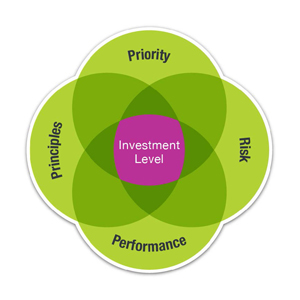
This illustration shows the factors that MnDOT leadership will consider when making investment decisions using the new Budgeting by Products and Services system. |
“We’re not going to allocate in the peanut butter-like way that we have in the past, where we generally spread the same level of operational funding increases across the agency,” said Judy Schmidt, resource management director, who will use the information to conduct long-term resource planning. “Rather, resource decisions will apply four drivers to determine level of investment: principles, products and services-based priority, risk and performance.”
Financial reports can be generated on different MnDOT services by using the Budgeting by Products and Services system. It pulls data from SWIFT, the state’s accounting and procurement system. Some of the reports are already created; others are in the works.
“This is a completely new way for districts and offices to look at what they do,” said Ross Hartzell, Budgeting by Products and Services administrator. “It will also make MnDOT more transparent. With the previous way we reported our finances, we didn’t have a standard approach for reporting how much we spend on services such as pavement and surface repair, snow and ice or freight rail improvements.”
- Long-term planning will also improve. A new resource management team will use the Product and Services work to develop what-if scenarios and collaborate with offices and districts to create four-year business plans.
“We’re very interested in making data-driven decisions, but our data has had limitations, both in terms of what we can fish out of the system and the silos that we put the data in,” Schmidt said. “This new framework will allow us to intentionally blur traditional district and division boundaries and make resource-driven decisions that are more relatable to the public.”
Learn more about Products and Services on iHUB.
|
 |
|

|
 |
TABLE of CONTENTS
 |
Statewide pedestrian system plan will create walkable communities |
By Sue Roe
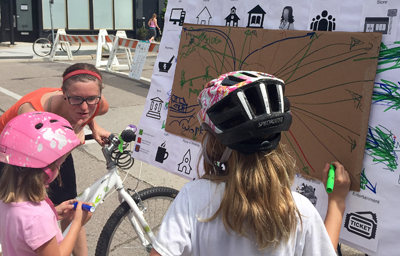
Greta Alquist, former MnDOT employee and now a transportation planner at Toole Design Group, talks with young bicyclists during the Minneapolis Open Streets Northeast event about the statewide pedestrian system plan. Photo by Jasna Hadzic |
MnDOT and the Minnesota Department of Health are partnering to develop the first ever statewide pedestrian system plan.
The two agencies are getting public comments this summer about the challenges and opportunities of walking in Minnesota’s communities. The plan will advance the Minnesota GO 50-Year Vision for Transportation, which is to maximize the health of people, the environment and the economy.
“This is the first time in the nation that state departments of transportation and health have aligned to create the plan,” said Jasna Hadzic, planner in the bicycle and pedestrian section of the Office of Transit. “By doing so, MnDOT and MDH are showing how partnerships can elevate the planning process and foster cross-agency communication on an issue that has a direct impact on the health and quality of life of Minnesotans.”
Public input will help establish the vision, goals and recommendations for the pedestrian system plan. The plan will help develop new projects, policies and programs that will improve the pedestrian environment at the state, regional and local levels. A draft plan is expected in 2016.
The first public engagements were July 12 at the Minneapolis Open Streets Northeast event and July 18 at Rondo Days in St. Paul. Other events, such as focus groups, listening sessions and online engagement, are being scheduled statewide.
“People were very curious and supportive at the first two events,” said Hadzic. “They were interested to hear about how the pedestrian plan would work on a statewide scale. We said it will improve the pedestrian environment by making their communities safer, convenient and more desirable to walk and roll.”
A background report, “Minnesota Walks: Current and Future Steps toward a Walkable Minnesota,” was created as a first step toward the plan’s development. The report was based on input from more than 50 stakeholder organizations with interests in walkability issues.
The report is based on the findings that walking is important, walking should be easier, that walking is harder for some people and that Minnesota is on track to improve walking. To read the report, go to www.minnesotago.org/walks.
“People of all ages and abilities depend on walking to access goods and services, participate in social activities and enjoy a good quality of life,” said Jean Wallace, Modal Planning and Program Management Division and co-chair of the project advisory committee. “We look forward to getting input from the public to learn more about how we can create walkable communities.”
More information about the project, online activities and the in-person engagement schedule is online at www.minnesotago.org/walks. For more information, contact Jasna.Hadzic@state.mn.us. Follow the project on Twitter at @minnesotago and use the hashtag #mnwalks. |
 |
|

|
 |
TABLE of CONTENTS
 |
2015 Truck Size and Weight Compliance workshop focuses on strategies |
|
By Marcia Lochner
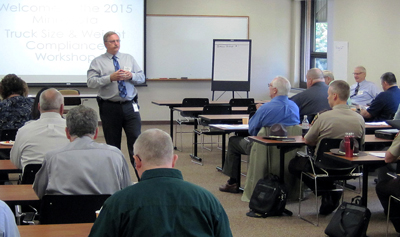
Mike Barnes, Assistant Commissioner, Operations Division, welcomes participants to the Truck Size and Weight Compliance Workshop in June. Photo by Marcia Lochner |
Commercial motor vehicles must comply with Minnesota’s laws regarding weight, height, length and width limitations that are designed to ensure safe vehicle operation on the state’s roadways and preserve investments in highway and bridge infrastructure. There is an ongoing need to coordinate application and enforcement of these laws among various stakeholders, such as law enforcement, highway engineering, traffic safety, and the trucking community.
To address this strategic need, MnDOT’s Office of Freight and Commercial Vehicle Operations hosted a Truck Size and Weight Compliance workshop in June. The discussions focused on operational issues, opportunities for improvement, agency roles and responsibilities, and a strategic direction for an effective truck size and weight compliance program in Minnesota.
The workshop brought together about 50 key stakeholders representing MnDOT leadership, Minnesota State Patrol, Missouri DOT, Wisconsin DOT, Federal Highway Administration, Federal Motor Carrier Safety Administration, local road authorities, Minnesota Trucking Association, MnDOT Districts and the MnDOT offices of Transportation System Management, Bridge, Maintenance, Pavement, and Traffic Safety.
Scales at fixed weigh stations, portable weigh scales and weigh-in-motion devices are all tools for truck size and weight enforcement.
“The scales play an important role in two capacities: protection of public safety and protection of infrastructure, and those two directly work hand and glove together,” said Dan Mulder, Wisconsin DOT.
According to Captain Jon Olsen, district commander for the Commercial Vehicle Section of the Minnesota State Patrol, they issued approximately 4,000 truck size and weight violations and performed 30,000 driver inspections and 22,000 truck inspections in 2014.
Attendees participated in real-time polling and breakout groups that generated ideas and discussions. Through these discussions, the group as a whole identified effective enforcement, education/outreach and infrastructure preservation as the top three goals for Minnesota’s truck size and weight compliance plan.
“Moving forward, OFCVO will take the information and feedback gathered from the workshop, and work with its partners to develop a truck size and weight compliance plan that all stakeholders can support,” said Bill Gardner, OFCVO director. |
 |
|

|
 |
TABLE of CONTENTS
 |
Red River weigh station is part of effort to improve weigh stations |
By Sue Roe

Trucks line up at the Red River Weigh Station on I-94 near Moorhead. The weigh station is closed until October for renovations, which include updated scale equipment and pavement improvement. Photo by Jerimiah Moerke |
The Red River Weigh Station along Interstate 94 east of Moorhead is closed for a few months for the installation of new scale equipment and pavement improvements. The station closed July 13 and will reopen in early October.
Ted Coulianos, permits supervisor, Office of Freight and Commercial Vehicle Operations, said the project is part of MnDOT’s statewide effort to improve all six of its fixed scale weigh stations.
The weigh stations are owned by MnDOT but fall under the jurisdiction of the Minnesota State Patrol. The main function of the weigh stations is to keep illegally overweight trucks off roads and bridges.
Staff at the weigh stations also performs safety inspections, driver qualification checks, load securement checks, proper and valid vehicle registration checks and contraband checks.
“Effective enforcement of the commercial vehicle size and weight laws preserves our infrastructure, resulting in less road and bridge repair,” said Coulianos. “Traffic is increasing in the state each year and roads and bridges deteriorate faster when weight restrictions are not followed.”
Good roads are also vital to the economy to keep goods and services efficiently moving throughout the state.
Last year significant improvements were made to the St. Croix Weigh Station, including new cameras and video recording equipment, new scale indicator heads, new over-height detectors and new signage.
In 2014, 340,210 vehicles weighed in at the six scale locations. Besides Red River and St. Croix, other locations are at Saginaw, Dayton Port, Erskine and Worthington. Three are located along interstates and three along state highways.
The State Patrol also uses MnDOT-owned mobile weigh-in-motion scales and portable mat scales along other roadways throughout the state. The State Patrol will use mobile weigh scales in the Moorhead area during the closure of the Red River station. |
 |
|

|
 |
TABLE of CONTENTS
 |
Donated vacation hours sought for four MnDOT employees |

Toby Tennison, with his wife, Bev, and grandchildren Evelyn, Brady and Emery, is eligible for the state vacation donation program. Photo courtesy of Tennison family |
Wayne (Toby) Tennison, Metro District training department; Farideh Amiri, Research & Library Services; Thomas Brown, District 2 transportation generalist and Gene Matthes, District 6 transportation generalist; are eligible for the state vacation donation program, which allows employees to donate up to 40 hours of vacation per fiscal year for approved recipients who have exhausted their sick and vacation leave due to injury or illness.
Tennison began with MnDOT in 1990. He worked in maintenance and the Bridge Office before joining the training team.
On April 16, Tennison was diagnosed with a life-threatening disease. As a result of his medical condition he is unable to work.
Amiri’s 21-year-old son, Roosbeh, was diagnosed with relapsed acute myeloid leukemia in June after an unsuccessful bone marrow transplant March 19.
This was Roosbeh’s second bone marrow transplant for his previous myelodysplastic syndrome in November 2009. He has suffered four different cancers in his 11-year fight.
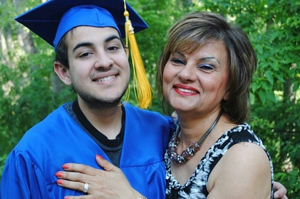
Farideh Amiriís 21 year old son, Roosbeh (Roozie), was diagnosed with relapsed acute myeloid leukemia in June. Farideh is eligible for the state vacation donation program. Photo courtesy of Amiri family |
Farideh Amiri has been a MnDOT employee for more than 18 years. She is currently a senior engineer at the Office of Transportation System Management, Research & Library Services.
Brown is a transportation generalist in District 2 at the Deer River Truck Station and has more than 26 years of service.
He was diagnosed with a life-threatening illness and has encountered complications that exhausted all of his sick and vacation leave.
Matthes has been with MnDOT in Albert Lea as a transportation generalist in Road Maintenance for 33 years.
In mid -2014 he was diagnosed with advanced cancer that began in his lungs and moved to multiple bones. This is a life-threatening, incurable cancer. Due to the associated pain from the cancer and side effects from the chemotherapy, he exhausted all of his sick and vacation leave accruals.
Employees may donate up to 40 hours of vacation per fiscal year; however, donations in any amount will be helpful. Hours donated are not considered taxable income for the donor nor are they considered tax-deductible expenses.
To donate, please:
- Log into the State Employee Self-Service website: (https://portal.s4web.state.mn.us/psp/por91ssap/SELFSERVICE/ENTP/h/?tab=MN_GUEST
- Click on “Other Payroll.”
- Click on “Leave donations.”
- Click on “Input Your Leave Donations,”
- Click on the magnifying glass next to “Reserve Bank” to open a list of names.
- Choose the employee’s name you would like to donate to.
- Enter the number of hours that you wish to donate.
- Click on the yellow “Save” box.
The paper form is also available online to donate to an employee on the Vacation Donation Program. |
 |
|

|
 |
TABLE of CONTENTS
 |
Postings for Managerial Rotation Program to open July 27 |
By Rich Kemp
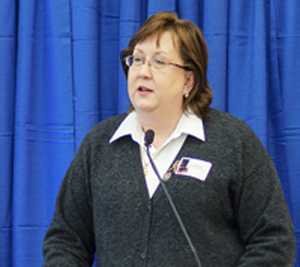
Bev Farraher participated in the Managerial Rotation Program as the bridge construction and maintenance supervisor. Photo by David Gonzalez |
The Managerial Rotation Program was developed to broaden the experience of current managers and help them be more successful in assuming increasing levels of responsibilities. The managerial rotation program started in 2004 and was rolled out again in 2014.
Postings for the upcoming rotations will be open from July 27 to Aug. 7. The next rotations are expected to last between six and 12 months.
“While the focus has been on engineering rotations, we also plan to expand the opportunity to non-engineering fields,” said Karin van Dyck, Human Relations director. “We are planning 10-12 opportunities, depending on the interest and work we are able to identify.”
The program benefits the agency and employees by offering participants an opportunity to learn about the work of another area of the department. By increasing and/or broadening the participants’ knowledge of MnDOT, the agency’s leadership becomes stronger and broader.
Eleven managers participated in the program in the past year.
“My managerial rotation was wonderful due to my coworkers, staff and supervisor,” said Bev Farraher, acting State Bridge Engineer. Farraher did a rotation from the Metro maintenance engineer position to bridge construction and maintenance supervisor.
“I appreciate the investment of energy and time that so many people made and the patience they had as I learned my managerial rotation position,” Farraher said. “The work was, and remains, fascinating and people have been kind, welcoming and very professional, yet with wonderful senses of humor. While learning much, I have tried to add value to the processes, products and services of the Bridge Office. There is a lot of new knowledge that I can bring back to my permanent job.”
Steve Lund, Maintenance Office director, participated in the program as Metro’s program delivery director.
“I really enjoyed my managerial rotation experience,” said Lund. “I developed a better understanding of pavement preservation that will that help me advance MnDOT's pavement preservation program. I renewed an appreciation for pavement and met some very interesting people.”
Evaluations have been conducted of the participants, host offices and home offices in the 2014 program.
“We are using this information and lessons learned to make this a more transparent process,” said van Dyck.
“I strongly recommend people consider such opportunities when they have a chance. There are challenges with any big change, it is rewarding and I gained wonderful experiences and memories,” said Farraher.
In addition to the Managerial Rotation Program, MnDOT offers a rotation program to Employee Resource Group members that includes participation in the Leadership Development Program.
If you are not a manager or a member of an ERG, you are encouraged to enroll in the Leadership Development Program, which is individually customized and flexible to meet each participant’s development goals. LDP remains open for application through July 24. See Newsline article about LDP. For more information, contact the LDP team at ldtteam@state.mn.us.
|
 |
|

|
|

|
 |
TABLE of CONTENTS
 |
Business areas test Internet Explorer 11 |
By Jackie Weldon
MnDOT will be transitioning from the current internet browser, Internet Explorer 9, to Internet Explorer 11. All MnDOT Application Stewards have been contacted regarding their applications and should be coordinating the testing of their web-based applications with IE11 now.
So that all application issues are resolved by the deadline of August 30, testing should be completed by August 7. Test results, both good and bad, should be reported to the IT Service Desk at 651-355-0200 or email to itservicedesk.dot@state.mn.us.
Beginning this fall, MN.IT will begin deployment to individual MnDOT computers. This upgrade will provide improved performance and user experience when using the internet. More information about IE11 can be found at www.makeuseof.com/tag/upgrade-internet-explorer-11-now/.
If you have questions please contact Karen Scott, Project Manager, at 651-366-4028 or karen.scott@state.mn.us or Jackie Weldon at 651-366-4043 or jackie.weldon@state.mn.us. |
 |
|

|
|

|
 |
TABLE of CONTENTS
 |
Using Microsoft Lync for videoconferencing begins Aug. 3 |
By Greg Ruhland
As Newsline brought to you in the last issue, MnDOT will use Microsoft Lync for videoconferencing beginning Monday, Aug. 3.
All videoconferences will be hosted as Lync online meetings. This transition means there will be some changes to how you participate in and schedule meetings. Reference materials will be posted in conference rooms, and Lync training videos and How To documents are available on iHUB.
Online Lync refresher sessions will be scheduled the last week of July and the first two weeks of August to introduce the new equipment, review how to schedule a Lync video conference and to answer any other questions or concerns. Additional information about these sessions will be emailed this week. Contact Joe Sass, corporate services division, for more information. |
 |
|

|
 |
TABLE of CONTENTS
 |
Library, St. Croix Crossing host middle-school students |
By Micheal Foley, Research Services & Library

National Summer Transportation Institute students search MnDOT Library materials during a scavenger hunt activity on Monday, July 13. Photo by Micheal Foley |
Thirty middle-schoolers eager to learn about transportation filled the MnDOT Library on the morning of Monday, July 13, to learn about how the specialty library works and what they could get out of a high school internship at MnDOT.
The visiting students were participants in the University of Minnesota’s National Summer Transportation Institute (NSTI), which is a free two-week summer day camp for students entering seventh through ninth grades. The camp, organized by the university’s Center for Transportation Studies (CTS), introduces students to a variety of engineering-, science-, transportation- or technology-related career fields through field trips and hands-on activities.
The first day of camp included two MnDOT activities: an hour-long session at the MnDOT library and a 90-minute boat tour of the St. Croix River Crossing construction site.
At the library, librarians Marilee Tuite and Karen Neinstadt presented slides explaining the top five reasons people use the MnDOT Library.
“One of our top reasons was that MnDOT Library saves your time,” Tuite said. “We wanted to show the library can support people at all stages of their career, from P.E. exam materials to technical standards out in the field.”
During the presentation, students also learned about a program that could help them get an early start in their career field. Jessica Etukudo, the SEEDS and Phoenix Program manager from MnDOT Human Resources, explained how students could benefit from participating in the Phoenix Program, MnDOT’s high school internship program that partners with Project Lead The Way schools across the state.
“I enjoyed speaking to the students. They had great energy, high spirits, and were every enthusiastic about the Phoenix Program and the potential to gain experience in the engineering field,” Etukudo said. “I hope to see some of them come through the Phoenix Program in the future.”
After the presentation, students took part in a tour of the library led by Neinstadt and fellow librarian Qin Tang. To test their knowledge, the students took part in a relay scavenger hunt to find specific library materials that librarians had placed clues on.
“I was pleasantly surprised and impressed that the students were so engaged. They worked well together in teams during the scavenger hunt despite having only met each other earlier that day,” Neinstadt said. “It was nice to have a young and eager group in the library.”
One of the items students had to find in the library’s stacks was a report about the St. Croix River Crossing project, which foreshadowed the NSTI activity planned for that afternoon. After lunch at the Central Office cafeteria, the students packed up and headed to Stillwater to board their boat for a tour of work currently underway along the river.
“They learned about the history of the lift bridge over the St. Croix River, and then they learned about the planning and construction of the new bridge with an up close and personal experience,” said Kylie Bivins, CTS program coordinator. “They were amazed at how long they've been building the bridge, how cement trucks are in the middle of the river, and the overall details of bridge construction.”
As NSTI continues, students will visit the Regional Transportation Management Center, the Minnesota Transportation Museum, the Minneapolis-St. Paul International Airport, Metro Transit, St. Paul Port Authority, UPS, engineering labs at the University of Minnesota. |
 |
|

|
|
| |
|



